Creating an effective email disclaimer is crucial for businesses in today’s digital landscape. A generic and ineffective disclaimer not only fails to provide legal protection but can also harm your brand reputation. Crafting a successful disclaimer that is tailored to your business can be challenging, but it is essential to ensure compliance with relevant laws and regulations while also effectively communicating important information to recipients.
The importance of a robust disclaimer message cannot be overstated. It serves several key purposes:
- Legal Protection: A well-crafted disclaimer can help protect your business from potential legal liabilities by outlining terms and conditions, limitations of liability, and other important legal information.
- Clarity and Transparency: By clearly stating your company’s policies, terms of use, and privacy practices, you demonstrate transparency to your recipients and build trust with them.
- Compliance: Depending on your industry and geographic location, there may be specific regulations governing the content of email communications. A disclaimer can help ensure compliance with these regulations.
- Brand Protection: An effective disclaimer can also help protect your brand reputation by addressing potential misunderstandings or misconceptions about your products or services.
What is an Email Disclaimer?
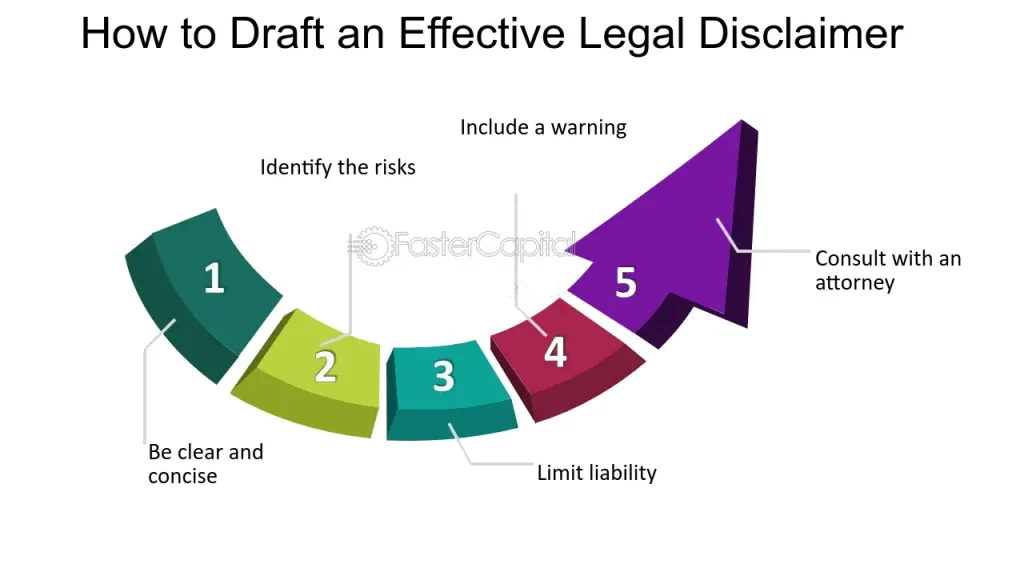
An email disclaimer is a statement typically located in the footer. It conveys information about the email’s content and usage and sets forth the terms and conditions for sending the email.
Well-crafted email disclaimers mitigate risks for both the sender and the recipient. They shield the sender from legal liability from errors or unforeseen consequences from the email’s content.
Simultaneously, recipients are apprised of expectations concerning privacy and the handling of sensitive data transmitted via email.
Therefore, if the recipient misuses the email content, the sender is shielded from potential lawsuits. Email disclaimers commonly fulfill the following functions:
- Guide misdirected emails
- Assert ownership of the content’s copyright
- Clarify that the email does not constitute a legally binding agreement
- Inform recipients that the views expressed in the email belong to the sender, not their employer.
Real LIfe Examples of Email Disclaimers:
1. Confidentiality Notice for Emails
Chances are, you’ve come across a confidentiality disclaimer in emails, often from professionals like accountants or attorneys.
A typical disclaimer might state, “This email and any information, files, or attachments are for the exclusive and confidential use of the intended recipient. If you are not the intended recipient…”
While legal opinions vary on its effectiveness, including such a notice is advisable if your emails contain sensitive information.
You may need it if Your email contains personal details beyond just the recipient’s name, such as membership numbers, payment data, or dates of birth.
Example: Expedia Group
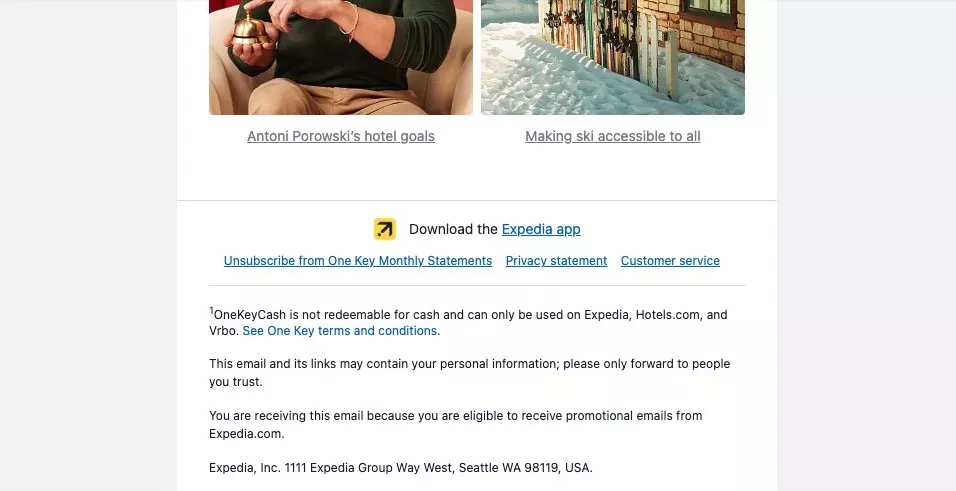
Expedia’s email footer features a succinct and clear confidentiality disclaimer, ensuring it’s easily noticed and understood. Its brevity makes it more likely for recipients to read and comprehend, and it doesn’t overwhelm with unnecessary details.
What stands out: Expedia’s disclaimer is notably shorter and straightforward compared to the norm. Yet, it effectively communicates the importance: “This email and its links may contain your personal information; please only forward to people you trust.”
2. Privacy Policy
What sets confidentiality apart from privacy?
Confidentiality is an ethical duty that safeguards against divulging information, while privacy is regarded as a fundamental human entitlement, encompassing respect for an individual’s personal life, home, and correspondence.
A privacy policy, also known as a privacy notice, is a legal instrument that outlines how an entity manages personal data. GDPR and CCPA (California) mandate including a privacy policy in emails.
Given their length, most brands opt to hyperlink to the full policy. The policy should be presented in plain language, be succinct, transparent, and easily accessible.
You may require it if: Any of your recipients reside in Europe, California, Colorado, Utah, or Virginia, or if you aim to enhance transparency regarding customer data usage.

Hyatt’s concise privacy policy links to the comprehensive version for those seeking a deeper understanding of how Hyatt handles their private information.
Moreover, it explicitly outlines the rights clients retain “…to access, to rectify, and to object for legitimate reasons to the processing of your data.”
This disclosure empowers Hyatt’s clientele, reassuring them that they maintain certain rights concerning their data usage, notwithstanding the existing safeguards provided by the privacy policy.
What stands out: Hyatt connects its privacy policy with a core company value—customer respect. Additionally, they offer a means to contact them for feedback or inquiries regarding data usage.
Learn why every website should ahve a privacy policy here.
3. Unmonitored Email Disclaimer
What occurs when a recipient responds to your mass email?
If you employ an email platform for distributing emails, you can designate any email address as the reply-to email — even one that doesn’t match the sender’s email.
Smaller enterprises often utilize a generic or the founder’s email as the reply-to address to consolidate all responses in a single inbox.
However, larger corporations employing a CRM or ticketing system may prefer customers to channel questions and support tickets differently, resulting in an unmonitored reply-to email.
In such cases, it’s essential to inform customers how to contact you instead of replying.
You might require it if: The reply-to email varies from the sender email or is unmonitored.
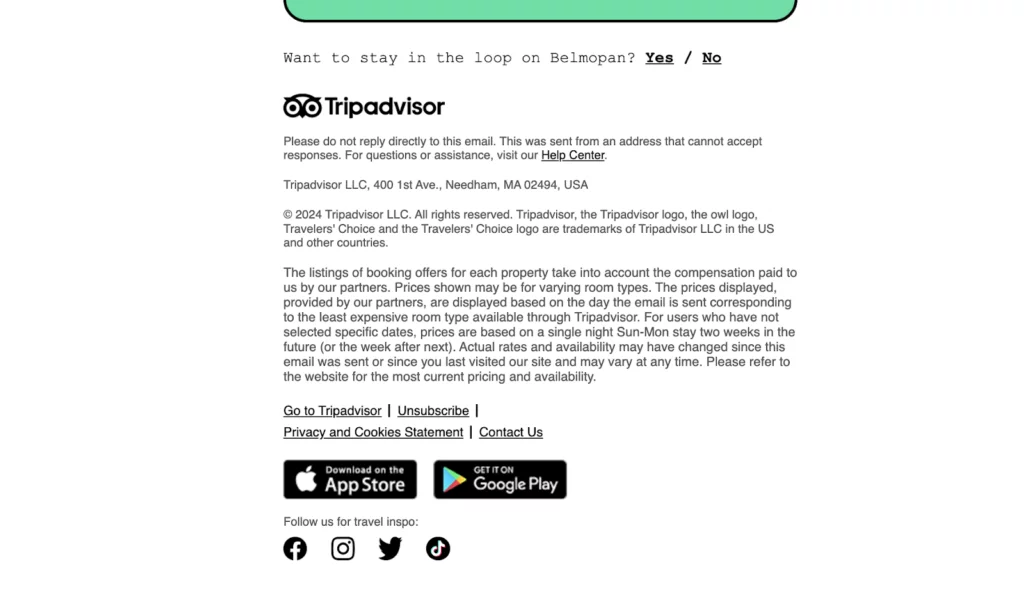
When recipients receive newsletters, they may have queries and might be inclined to reply.
Encountering an unexpected bounce-back could leave them feeling neglected and uninformed. A disclaimer can guide them to the appropriate channel.
Tripadvisor informs email recipients that the specified email address cannot receive responses and redirects them to their Help Center.
What stands out: TripAdvisor’s email disclaimer regarding replies is succinct yet explicit. It also provides an alternative method for customers to contact TripAdvisor if needed.
4. Copyright and Trademark Notices
If your company holds trademarks or copyrighted materials, safeguarding your intellectual property is crucial. Including a copyright and trademark notice informs your audience that the content cannot be reproduced without permission.
You may need it if your email mentions any trademarks or copyrighted materials you or others own. This could encompass references to partners, products, platforms (such as Apple or Google Play stores), and more.
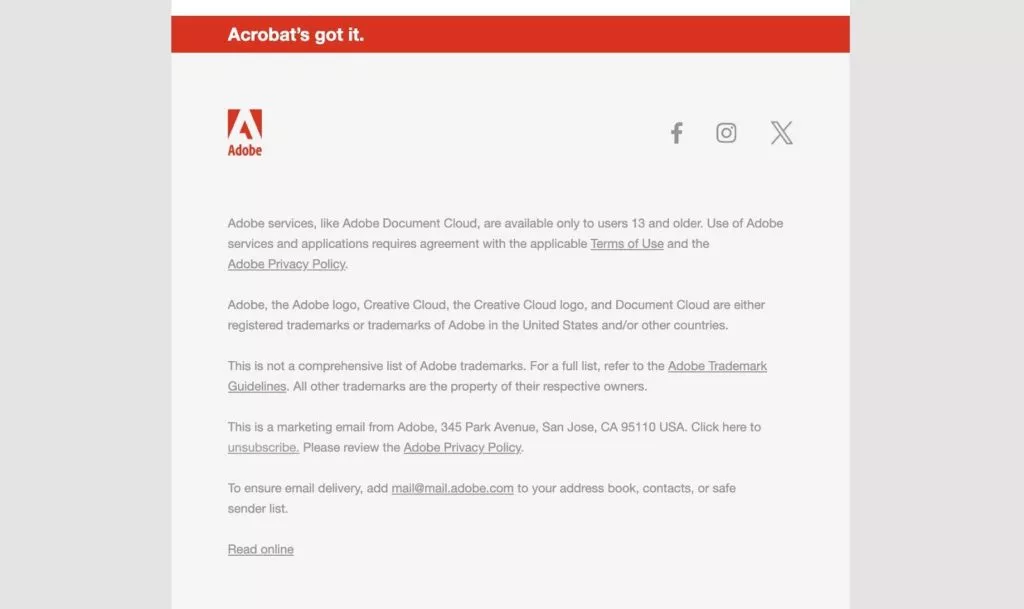
Adobe’s trademark notice is clear and comprehensive. It highlights the primary trademarks protected by law and links to detailed trademark guidelines.
Understanding its message doesn’t require a legal background — refrain from misusing the company’s branding. Additionally, it distinguishes between Adobe’s proprietary assets and those owned by others.
What stands out: The succinct phrase shields Adobe from unintentional trademark infringement: “All other trademarks are the property of their respective owners.”
5. Terms and Conditions/Offer Restrictions
For businesses running email promotions, this disclaimer is essential.
The terms and conditions in your email footer serve as the fine print for consumers. Consider a promotion offering a free tumbler with each purchase. Informing customers about the promotion’s end date, location restrictions, or minimum purchase amount is crucial.
While you want to ensure your header and body copy are clear with every detail, these terms are still vital, hence the email disclaimer.
You may need it if you sell products or services or are conducting a sale, contest, or sweepstakes. Terms and conditions are crucial for financial products like credit card offers or sweepstakes with potential tax implications.

Some promotional disclaimers inundate readers with extensive text detailing promotional periods, location restrictions, and other offer-specific information.
Instead of crafting unique disclaimers for each promotion, online retailer Primary opts for a blanket statement: “All promotions are limited time only, while supplies last. Sale prices are marked and subject to change.”
What stands out: To further shield themselves from liability, Primary reserves “the right to modify or cancel promotions at any time.”
6. HIPAA Email Disclaimer
For those in the healthcare industry, familiarity with HIPAA is essential. At first glance, a HIPAA email disclaimer resembles a confidentiality notice. It often states that the email contains confidential information intended solely for the recipient.
However, HIPAA email disclaimers take an additional step by outlining various communication methods the company may use to share medical information and providing instructions on how recipients can adjust their preferences if necessary.
While adding a disclaimer isn’t sufficient to ensure HIPAA compliance—for instance, customers must opt in, and emails must be encrypted—it’s a step in the right direction.
You may need it if You’re a healthcare provider or insurer transmitting information electronically.
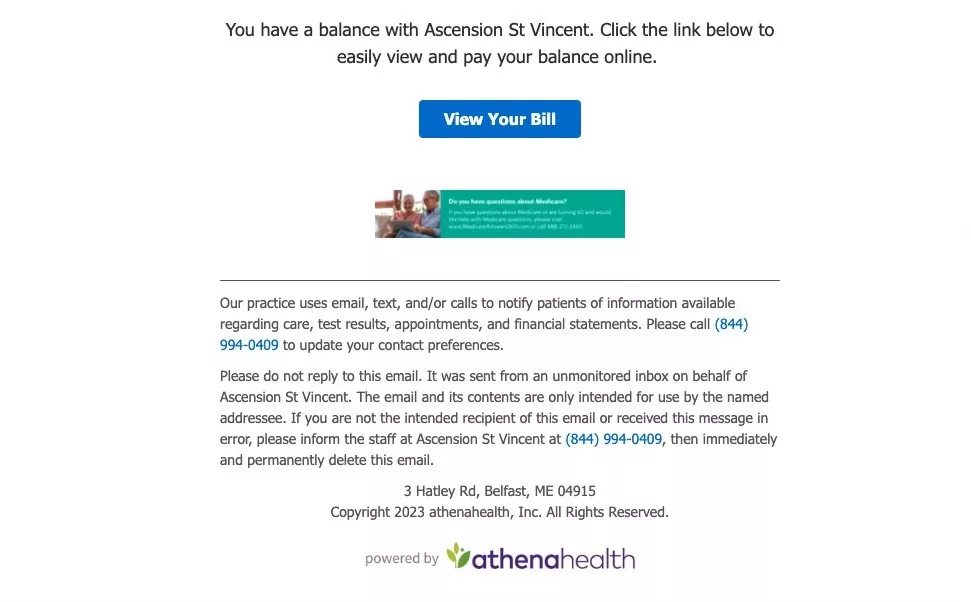
The HIPAA disclaimer provided by Ascension St. Vincent clearly outlines how the medical practice communicates with patients and gives examples of confidential information it might transmit. It also offers a straightforward method for recipients to contact them to update communication preferences.
What stands out: The disclaimer emphasizes the recipient’s responsibility in case of a mis-send. Recipients are urged to inform Ascension St. Vincent promptly and delete the information immediately and permanently.
7. Unsubscribe Link
It’s crucial to make it easy for customers to end the relationship, and an email disclaimer can help with that.
While a one-click unsubscribe option is the gold standard, providing other options, such as unsubscribing by email or through an email preferences center, is also beneficial.
Maintain a light tone. Injecting a bit of personality, like in the example below, is fine, but avoid extremes that might shame the recipient.
Pro tip: To reduce unsubscribes, offer context on how the recipient joined your email list, such as: “This email was sent to you because you signed up for our newsletter at [website URL].”
You may need it if you send mass emails. Unsubscribe instructions are legally required in the U.S., Canada, and Europe.
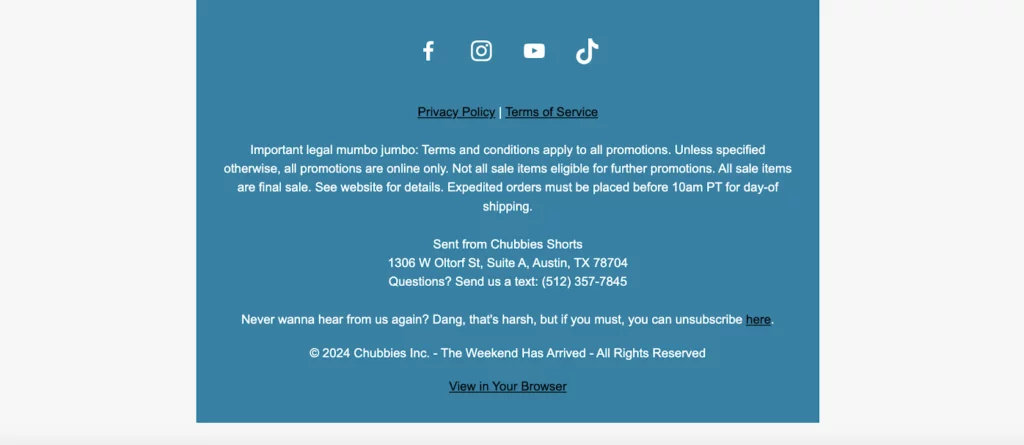
What stands out: Men’s retailer Chubbies adds personality and humor to its unsubscribe text while indicating how to remove oneself from the list. This adds a touch of entertainment for recipients who reach this section of the email. It’s a clever way to infuse extra personality into the newsletter.
8. Combo Disclaimers
For many companies, incorporating multiple disclaimers into their footer is necessary.
As the number of disclaimers grows, it becomes increasingly important to condense the text and organize the disclaimers so that readers can quickly find what they’re looking for.
You might need it if You have more than one disclaimer to include.

Ikea operates in numerous countries and markets, so it opts for simplicity in its disclaimers, using links to direct users to its contact, privacy policy, and unsubscribe pages.
What stands out: Ikea efficiently provides necessary information while maintaining a clean and concise footer. The company creates a comprehensive disclaimer section by combining various types of disclaimers. Mixing and matching different types of disclaimers can be a practical approach.
Best Practices to Follow While Preparing the Email Disclaimer:
- Understand Legal Requirements: Before drafting your email disclaimer, familiarize yourself with relevant laws and regulations governing email communication in your jurisdiction and industry. This may include data protection laws (e.g., GDPR, CCPA), advertising standards, consumer protection regulations, and industry-specific requirements. Ensure that your disclaimer addresses all applicable legal obligations to provide adequate protection for your organization.
- Keep It Concise and Clear: A good email disclaimer should be brief and to the point. Avoid using overly complex language or lengthy paragraphs that may confuse or overwhelm recipients. Focus on conveying essential information in a clear and understandable manner, using plain language that is accessible to all recipients.
- Include Key Elements: Your email disclaimer should cover important aspects such as confidentiality, legal liability, data protection, copyright, and compliance with relevant laws. Clearly state the purpose of the disclaimer and the rights and responsibilities of both the sender and recipient. Include contact information for inquiries or concerns regarding the disclaimer or email content.
- Tailor to Your Business Needs: Customize your email disclaimer to reflect the specific practices, policies, and requirements of your organization. Consider factors such as the nature of your business, the types of emails you send, and the audience you target. Ensure that the disclaimer aligns with your brand identity and values while effectively communicating your legal obligations and commitments to recipients.
- Regularly Review and Update: Email disclaimers should be periodically reviewed and updated to reflect any changes in legal requirements, business practices, or industry standards. Regularly assess the effectiveness of your disclaimer and make adjustments as needed to ensure continued compliance and relevance.
- Seek Legal Advice if Necessary: If you are unsure about the legal implications of certain provisions or wording in your email disclaimer, consider seeking advice from a legal professional specializing in email communication and data privacy. A lawyer can help ensure that your disclaimer provides adequate protection for your organization and complies with relevant laws and regulations.
- Provide Accessibility: Ensure that your email disclaimer is accessible to all recipients, including those with disabilities. Use plain text or provide alternative formats for individuals using screen readers or other assistive technologies. Consider including a link to a web page where recipients can access the disclaimer in a more accessible format if necessary.
Conclusion:
Crafting an effective email disclaimer is a crucial aspect of email communication for businesses across various industries. A well-crafted disclaimer serves multiple purposes, including legal protection, maintaining transparency with recipients, and safeguarding the brand reputation of the organization. However, creating a disclaimer that effectively achieves these objectives while remaining concise and clear can be a challenging task. Nonetheless, it is an essential endeavor for businesses to undertake to ensure compliance with laws and regulations governing email communication and to mitigate potential risks.
FAQs on Email Disclaimers:
How can I customize an email disclaimer template?
To customize an email disclaimer template, businesses should review their specific legal requirements, industry regulations, and brand policies. They can then tailor the template to include relevant information and language that reflects their unique needs.
Are there any free resources available for crafting email disclaimers?
Yes, there are several free resources available online that offer email disclaimer templates and guidance on crafting effective disclaimers. These resources can serve as a starting point for businesses looking to create customized disclaimers.



